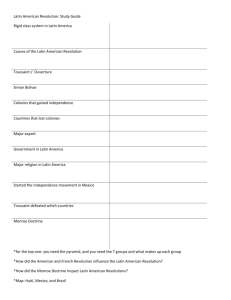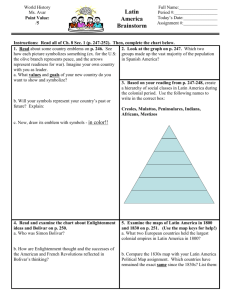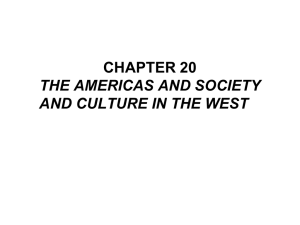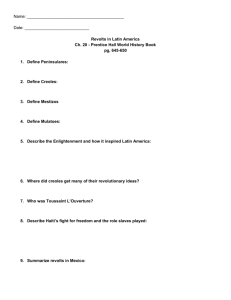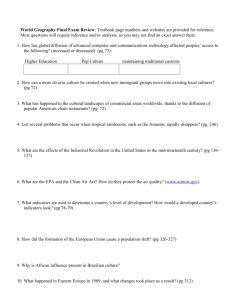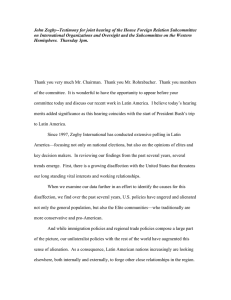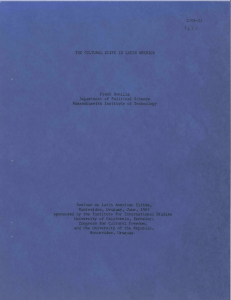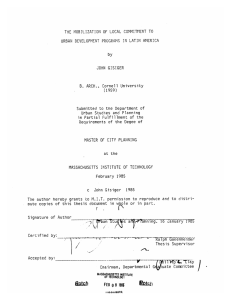The Emergence of Mass Society in the West. - Leleua Loupe
advertisement
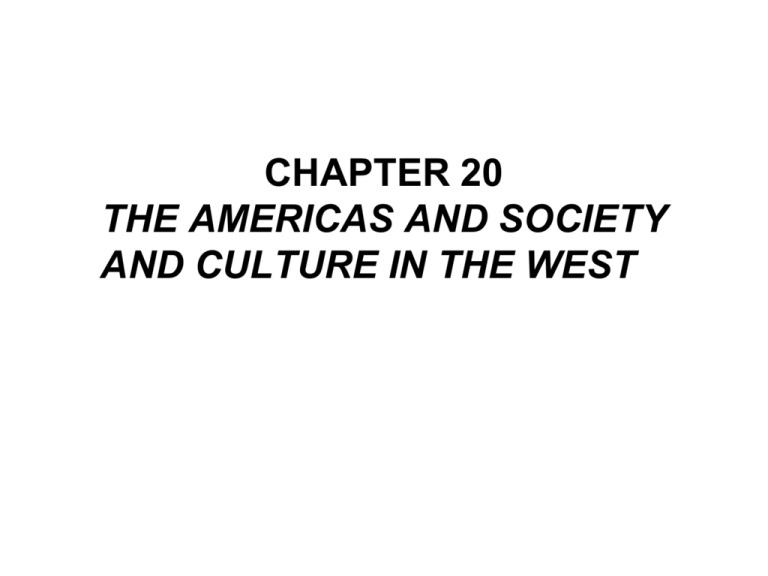
CHAPTER 20 THE AMERICAS AND SOCIETY AND CULTURE IN THE WEST Latin America: 19th & early 20th C • Q: What role did liberalism and nationalism play in Latin America Between 1800 and 1870? • Q: What were the major economic, social and political trends in Latin American in the late 19th and early 20th Centuries. Challenge to Spanish & Portuguese Colonialism • Influence of Enlightenment ideals & upheavals in the Napoleonic era – The Wars for Independence • Creole Elites: descendants of Europeans • Simon Bolivar of Venezuela • Jose de San Martin of Argentina – Principle of Equality of all people under law – Free trade – Free press » Did not apply to everyone Toussaint L’Ouverture,Haiti, 1804 © North Wind Picture Archives Nationalistic Revolts • Mexican Independence, 1810 – Miguel Hidalgo Y Costilla – Represented a peoples revolution • September 16, 1910 crushed • Creoles & Peninsulars united to defeat the popular revolution – Augustin de Iturbide, first emperor of Mexico, 1821 • No political or economic changes “Liberator” of South America • Venezuela (1819) •Colombia •Ecuador •Perus •Simon Bolivar leading his troops across the Andes in 1823 to fight in Peru © SuperStock “Liberators” of South America •San Jose Martyn is shown leading his troops at the Battle of Chacabuco, Chile, 1817. By1824: Free states: Uruguay, Paraguay, Colombia, Venezuela, Argentina, Bolivia Chile • Latin America in the First Half of the Nineteenth Century Nation Building • The Difficulties of Nation Building (1830-187)) – Consequences of Wars for independence • Loss of population, property and livestock • Boundary disputes • Poor transportation and communication challenged unity and fostered regionalism • European & American intervention • Monroe Doctrine, 1823 Political Obstacles • Different types of leadership • Caudillos (leaders) of New Republics – National Caudillos • Autocrats: Supported elites and controlled state revenues, favored centralized power and unity of states – worked against the majority’s interests – Sometimes were modernizers in that they build infrastructure, canal, ports, schools, Economic Patterns • Great Britain & America dominated Latin American economy – Raw materials & new Markets • Incredible disparity of wealth – Landed elite • Land basis of wealth, social prestige, political power • Controlled government, courts • Maintained system of debt peonage Foreign Investments • 1870 – 1913 foreign investments boomed – British investment: • Growth from 85 to 757 million pound, 2/3 of all foreign investments – Railroads – Mining – Public utilities • Slavery technically abolished in 1888 • Most people remained subservient and dependent on elite and foreigners Catholic Church • Enormous land holdings-Exercised great power • Clerics took position in new governments following independence – Considerable influence • Conflict of church & state – Liberals wanted to curtail powers of church – Conservatives hoped to maintain privileges and power of church Working Class • Growth of labor unions – Radical unions advocated use of the general strike as an instrument for change • Lack of suffrage • Political Change after 1870 – Landed Elite • Controlled government • produced constitutions similar to those of the US and Europe • limited suffrage maintained concentration of power Dictators • Some landowners made use of dictators to maintain the interests of the ruling elite. – Porfirio Diaz , Mexico, Ruled 1876 – 1910, • established a conservative, centralized government – support of the army, foreign capitalists, large landowners, and the catholic church. • Consequences of Dictatorship: – real wages of working class declined, – 95% of rural population owned no land, – 1000 families owned the land. Economy after 1870 • Growth of economy – Modernization & wealth a veneer – Enjoyed by the wealthy minority • Rural elites dominated workers – Indians impoverished – Debt servitude – Dependent on foreigners Emiliano Zapata •Liberal landowner Francisco Madero, forced Diaz from power •Madera’s ineffectiveness to carry out sufficient reform triggered a demand for agrarian reform led by Zapata © Snark/Art Resource, NY Mexican Revolution, 1910 • He aroused the revolutionary impulse of landless – Seized the haciendas (plantations) of the wealthy • Impact of revolution – destroyed the economy – new constitution in 1917 United States Intervention • United States emergence as a world power – interfered into the economies of Latin America • The Spanish American War 1898 – Platt Amendment (1901) Cuba – Foraker Act (1900) Puerto Rico • Between 1898 – 1934 – sent military forces to Cuba, Mexico, Guatemala, Honduras, Nicaragua, Panama, Columbia, Haiti, and the Dominica Republic Imperialists • Take up the White Man's burden-Send forth the best ye breed-Go, bind your sons to exile To serve your captives' need; To wait, in heavy harness, On fluttered folk and wild-Your new-caught sullen peoples, Half devil and half child..." • Rudyard Kipling - McClure's Magazine 12 (Feb. 1899). Mass Society • Mass Education – After 1870 most western states provided free compulsory primary education • Mass Leisure – Confined to boundaries of Industrial System New Age of Science • Renewed interest in scientific research – Louis Pasteur, Germ Theory of disease • Charles Darwin, On the Origin of Species by Means of Natural Selection, 1859 • Rise of Pseudo-Science – Social Darwinism • Herbert Spencer • Houston Stewart Chamberlain Zionsim Palestine in 1900 Romanticism Attraction to exotic and unfamiliar Non-western figures such as Samuel Taylor Coleridge’s Kubla Khan Euge`ne Delacroix, Women of Algiers © Erich Lessing/Art Resource, NY Fascination and misticism of nature Caspar David Friedrich, Man and Woman Gazing at the Moon © Bildarchiv Preussischer Kulturbesitz/Art Resource, NY Gustave Courbet, The Stonebreakers •Realism •Most famous of the realist artists, portrayed things as they actually appeared © Oskar Reinhart Collection/The Bridgeman Art Library

